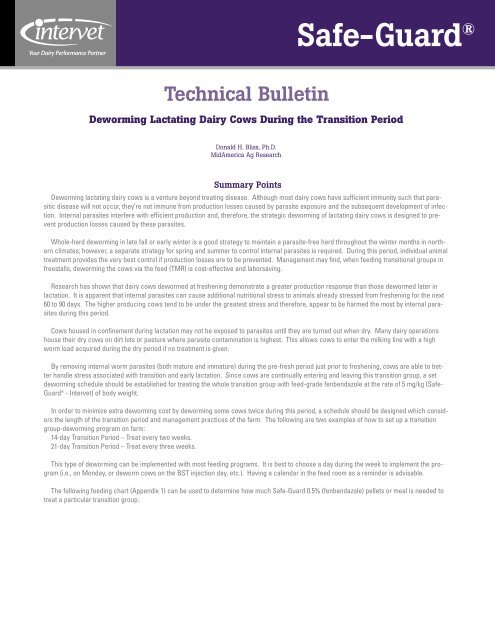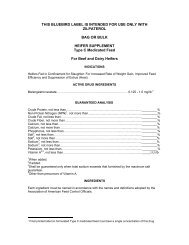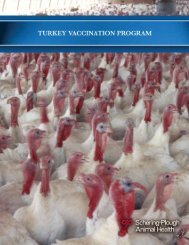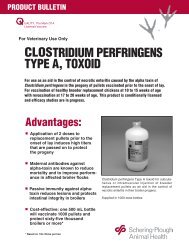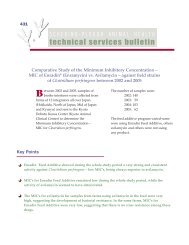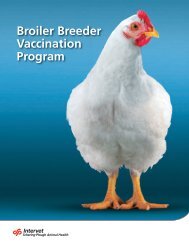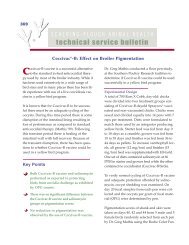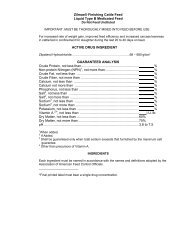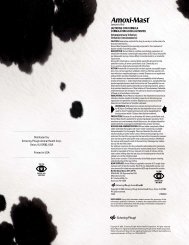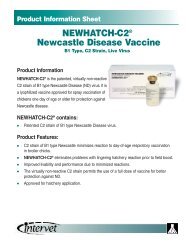SAFE-GUARD® - Deworming Lactating Dairy Cows During The
SAFE-GUARD® - Deworming Lactating Dairy Cows During The
SAFE-GUARD® - Deworming Lactating Dairy Cows During The
Create successful ePaper yourself
Turn your PDF publications into a flip-book with our unique Google optimized e-Paper software.
Technical Bulletin<br />
Donald H. Bliss, Ph.D.<br />
MidAmerica Ag Research<br />
Safe-Guard ®<br />
<strong>Deworming</strong> <strong>Lactating</strong> <strong>Dairy</strong> <strong>Cows</strong> <strong>During</strong> the Transition Period<br />
Summary Points<br />
<strong>Deworming</strong> lactating dairy cows is a venture beyond treating disease. Although most dairy cows have sufficient immunity such that parasitic<br />
disease will not occur, they’re not immune from production losses caused by parasite exposure and the subsequent development of infection.<br />
Internal parasites interfere with efficient production and, therefore, the strategic deworming of lactating dairy cows is designed to prevent<br />
production losses caused by these parasites.<br />
Whole-herd deworming in late fall or early winter is a good strategy to maintain a parasite-free herd throughout the winter months in northern<br />
climates; however, a separate strategy for spring and summer to control internal parasites is required. <strong>During</strong> this period, individual animal<br />
treatment provides the very best control if production losses are to be prevented. Management may find, when feeding transitional groups in<br />
freestalls, deworming the cows via the feed (TMR) is cost-effective and laborsaving.<br />
Research has shown that dairy cows dewormed at freshening demonstrate a greater production response than those dewormed later in<br />
lactation. It is apparent that internal parasites can cause additional nutritional stress to animals already stressed from freshening for the next<br />
60 to 90 days. <strong>The</strong> higher producing cows tend to be under the greatest stress and therefore, appear to be harmed the most by internal parasites<br />
during this period.<br />
<strong>Cows</strong> housed in confinement during lactation may not be exposed to parasites until they are turned out when dry. Many dairy operations<br />
house their dry cows on dirt lots or pasture where parasite contamination is highest. This allows cows to enter the milking line with a high<br />
worm load acquired during the dry period if no treatment is given.<br />
By removing internal worm parasites (both mature and immature) during the pre-fresh period just prior to freshening, cows are able to better<br />
handle stress associated with transition and early lactation. Since cows are continually entering and leaving this transition group, a set<br />
deworming schedule should be established for treating the whole transition group with feed-grade fenbendazole at the rate of 5 mg/kg (Safe-<br />
Guard ® - Intervet) of body weight.<br />
In order to minimize extra deworming cost by deworming some cows twice during this period, a schedule should be designed which considers<br />
the length of the transition period and management practices of the farm. <strong>The</strong> following are two examples of how to set up a transition<br />
group-deworming program on farm:<br />
14-day Transition Period – Treat every two weeks.<br />
21-day Transition Period – Treat every three weeks.<br />
This type of deworming can be implemented with most feeding programs. It is best to choose a day during the week to implement the program<br />
(i.e., on Monday, or deworm cows on the BST injection day, etc.). Having a calendar in the feed room as a reminder is advisable.<br />
<strong>The</strong> following feeding chart (Appendix 1) can be used to determine how much Safe-Guard 0.5% (fenbendazole) pellets or meal is needed to<br />
treat a particular transition group.
Appendix 1: Amount of fenbendazole (0.5%) needed for ration.<br />
Intersect number of cows on the left-hand side with the average weight located across the top to give you the pounds of pellets/meal needed.<br />
Part #: 60141 TCPA 04/01<br />
Data on file, Intervet Inc.<br />
© 2001, Intervet Inc.<br />
Number 1000 Lb 1100 Lb 1200 Lb 1300 Lb 1400 Lb 1500 Lb 1600 Lb<br />
of Head <strong>Cows</strong> <strong>Cows</strong> <strong>Cows</strong> <strong>Cows</strong> <strong>Cows</strong> <strong>Cows</strong> <strong>Cows</strong><br />
1 1.0 1.1 1.2 1.3 1.4 1.5 1.6<br />
2 2.0 2.2 2.4 2.6 2.8 3.0 3.2<br />
3 3.0 3.3 3.6 3.9 4.2 4.5 4.8<br />
4 4.0 4.4 4.8 5.2 5.6 6.0 6.4<br />
5 5.0 5.5 6.0 6.5 7.0 7.5 8.0<br />
6 6.0 6.6 7.2 7.8 8.4 9.0 9.6<br />
7 7.0 7.7 8.4 9.1 9.8 10.5 11.2<br />
8 8.0 8.8 9.6 10.4 11.2 12.0 12.8<br />
9 9.0 9.9 10.8 11.7 12.6 13.5 14.4<br />
10 10.0 11.0 12.0 13.0 14.0 15.0 16.0<br />
11 11.0 12.1 13.2 14.3 15.4 16.5 17.6<br />
12 12.0 13.2 14.4 15.6 16.8 18.0 19.2<br />
13 13.0 14.3 15.6 16.9 18.2 19.5 20.8<br />
14 14.0 15.4 16.8 18.2 19.6 21.0 22.4<br />
15 15.0 16.5 18.0 19.5 21.0 22.5 24.0<br />
16 16.0 17.6 19.2 20.8 22.4 24.0 25.6<br />
17 17.0 18.7 20.4 22.1 23.8 25.5 27.2<br />
18 18.0 19.8 21.6 23.4 25.2 27.0 28.8<br />
19 19.0 20.9 22.8 24.7 26.6 28.5 30.4<br />
20 20.0 22.0 24.0 26.0 28.0 30.0 32.0<br />
21 21.0 23.1 25.2 27.3 29.4 31.5 33.6<br />
22 22.0 24.2 26.4 28.6 30.8 33.0 35.2<br />
23 23.0 25.3 27.6 29.9 32.2 34.5 36.8<br />
24 24.0 26.4 28.8 31.2 33.6 36.0 38.4<br />
25 25.0 27.5 30.0 32.5 36.0 37.5 40.0<br />
26 26.0 28.6 31.2 33.8 36.4 39.0 41.6<br />
27 27.0 29.7 32.4 35.1 37.8 40.5 43.2<br />
28 28.0 30.8 33.6 36.4 39.2 42.0 44.8<br />
29 29.0 31.9 34.8 37.7 40.6 43.5 46.4<br />
30 30.0 33.0 36.0 39.0 42.0 45.0 48.0<br />
31 31.0 34.1 37.2 40.3 43.4 46.5 49.6<br />
32 32.0 35.2 38.4 41.6 44.8 48.0 51.2<br />
33 33.0 36.3 39.6 42.9 45.2 49.5 52.8<br />
34 34.0 37.4 40.8 44.2 47.6 51.0 54.4<br />
35 35.0 38.5 42.0 45.5 49.0 52.5 56.0<br />
36 36.0 39.6 43.2 46.8 50.4 54.0 57.6<br />
37 37.0 40.7 44.4 48.1 51.8 56.5 59.2<br />
38 38.0 41.8 45.6 49.4 53.2 57.0 60.8<br />
39 39.0 42.9 46.8 50.7 54.6 58.5 62.4<br />
40 40.0 44.0 48.0 51.0 54.0 60.0 64.0<br />
41 41.0 45.1 49.2 53.3 57.4 61.5 65.6<br />
42 42.0 46.2 50.4 54.6 58.8 63.0 67.2<br />
43 43.0 47.3 51.6 55.9 60.2 64.5 68.8<br />
44 44.0 48.4 52.8 57.2 61.6 66.0 70.4<br />
45 45.0 49.5 54.0 58.5 63.0 67.5 72.0<br />
46 46.0 50.6 55.2 59.8 64.4 69.0 73.6<br />
47 47.0 51.7 56.4 61.1 65.8 70.5 75.2<br />
48 48.0 52.8 57.6 62.4 67.2 72.0 76.8<br />
49 49.0 53.9 58.8 63.7 68.6 73.5 78.4<br />
50 50.0 55.0 60.0 65.0 70.0 75.0 80.0<br />
Intervet Inc. ■ P.O. Box 318 ■ 405 State Street ■ Millsboro, Delaware 19966<br />
1.800.835.0541 Information ■ 1.800.441.8272 Vet Orders Only<br />
www.intervetusa.com


